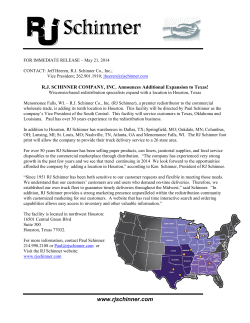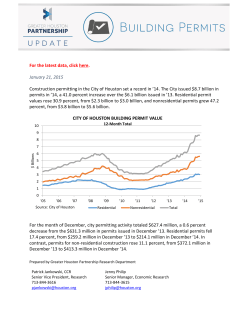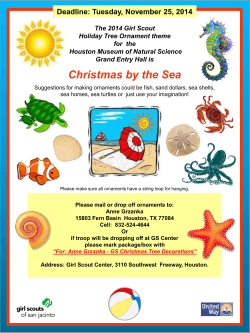
March - Bromeliad Society/Houston
Bromeliad Society Vol 48 No 3 March, 2015 BS/H Spring Bromeliad Sale S pring is right around the corner and so is our Spring Bromeliad Sale! The sale will be held at the West Gray Multi-Service Center where we are currently holding our meetings. The date is Saturday, April 11 from 9:00 a.m. until 3 p.m. Setup begins at 8:00 a.m. Customers usually start showing up around 8:15 a.m. to grab the best ones. MEETING DATE: Tuesday, March 17, 7:30 p.m. PROGRAM SPEAKER: Dr. Steve Reynolds PROGRAM TITLE: “Yes — You too can show bromeliads” Steve will show us how to choose the best show plants and discuss the best ways to groom them to be winners. SEEDLING: Neoregelia ‘Red Bird’ Supplied by Jimmy Woolsey. An Oeser hybrid of unknown parentage. Care is typical for neoregelias: porous mix, good water and bright indirect light for best color. Photo courtesy of Tropiflora and the BSI BCR website. MEETING AGENDA: Greetings/Call to Order/Member Saleii Show and Tell Meeting Break/Refreshments/Buy raffle tickets/Plants Program Raffle Adjourn APRIL PROGRAM: NEXT BOARD MEETING: TBA Thurs., 3/19, 7:00 p.m. DEADLINE FOR APRIL BULLETIN: 3/28/15 **Note there is a member sale at this meeting! Remember that all bromeliads must be named correctly. This applies to all Sales and the Raffle Table. Minimum price for bromeliads is $5. Please double tag your sale plants with your sale number on each tag and the bromeliad info on just one tag. Please email me at deliboys@comcast.net if you plan on selling at any sale. Once again we will need plastic bags, small boxes and soft drink boxes for the plants. I will be bringing breads (white and wheat), deli meats (turkey, ham and roast beef) and cheeses (Swiss and cheddar) along with lettuce, pickles, tomatoes and mustard and mayo. (Breakfast donations and beverages are always appreciated by our hardworking staff. — Editor) Remember….we can’t have a good sale if you don’t bring bromeliads. Thanks!! Allyn LAST FREEZE? Hopefully the weather man was correct when he said it was unlikely that Houston will have another freeze this season. Some warm, sunny days will help our plants and should get us in the mood to play in the dirt (bromeliad mix). Please start working with your potential show entries and deciding which plants you are going to sell. It is only about eight weeks until Show/Sale time! Charlien F President’s Page or the most part I haven’t minded the cold rainy weather we have had of late. I am still on my cleanup and organize kick, and for the most part I am happy to stay inside, be it house or greenhouse, and using an old library term ‘weeding’. To a librarian, weeding is a process that involves observing a collection of books and evaluating it. Which books to be kept, which books need to be removed? What gaps have opened? What books should be added to the display area? The last step is to organize the remaining books. To them it is the natural order of an evolving collection. Does that remind you of a collection that you have? You had better say “Yes, my plants.” Late winter or early spring is a great time to weed your plants. I don’t just mean in a horticultural sense, but also in a library sense. Look at your collection carefully. Do you see plants that you just don’t like anymore? Get rid of them! Do you see plants that you have over propagated? Do you really need 6 pots of Neoregelia ampullacea X Neoregelia 'Fireball'? Probably not, but someone else might. This would be a great time to set some nice plants aside donate to the raffle table or to take to the April 11th sale. Do some of those Billbergias have scale? Do you toss, or quarantine and medicate? How about that Pitcairnia burle-marxii that you just had to buy, and then found out it wants to grow in a tropical swamp where the humidity hovers around 90% all of the time? Even Houston can’t quite make it happy; toss or pamper? While you are weeding is a great time to update your bookkeeping. Do all the plants have tags? Are the names correct? Are they spelled correctly? Have you noted optimal growing conditions? This would be a great time to choose the plants that you want to put on display at the May show. I could go on, but I hope you get the idea. I have been weeding the greenhouse and noticed the beautiful blooming plants. When the weather clears up a little, I will take some pictures. Late February through early March is when my Aechmea recurvatas bloom. I have about 6 or 8 different clones. Some have valid names and some, well let us just say that a few of our nursery friends are quite creative in getting us to buy ‘new’ plants. Sorting them out is a job for another time, but good photographs of blooming plants will certainly help. Malcolm McCorquodale’s program on photographing plants gave me some great new techniques that I can use. Don’t forget the sale coming up in April. It will be held at the Multi-Service Center on April 11, 2015. If you have questions, please contact our Plant Sales Committee chairperson Allyn Pearlman. I want to take care of a piece of old business that I forgot to handle at the last meeting. I promised Midge Gorman, our Courtesy Committee chairperson, that I would mention that she has not had a lot of work to do lately. Midge is in charge of sending cards to members who have had some type of misfortune. If you know a member who is in need of a get well or sympathy card please let Midge, Carole Richtmyer or me know. We will get the word out to the proper people. You can email me at BromeliadSocietyHouston@gmail.com. Malcolm gave a very informative program last month, and I look forward to Steve Reynolds’ upcoming program. This month Steve is going to show us how to get our plants ready for entry into a show. Perhaps more importantly, he is going to discuss why you should want to go to all the trouble to enter plants. I am sure this month’s program will be an eye opener. Steve grows some great plants and I am hoping I can pick up a few tricks on grooming. Here is hoping for fair weather, warm temperatures, and seeing you at the March meeting. 2 Meet our March Speaker: Dr. Steve Reynolds Steve Reynolds lives in Austin, Texas, and works as a veterinarian to help support his bromeliad habit. His interest in bromeliads dates back to the early 80’s when a favorite aunt gave him a Billbergia nutans and Billbergia pyramidalis striata, which he still has in his collection. He joined his first bromeliad club in 2005, the Bromeliad Society of Austin, and became one of the driving forces in that society. In 2007, he began going to the Southwest Guild Bromeliad Shows and subsequently joined the Bromeliad Society/Houston. Steve likes many different species of bromeliads, making it difficult to pick one favorite as he continues to expand his collection. He became a BSI accredited judge in 2011, and currently serves as a Director for the BSI, president of both the Southwest Bromeliad Guild and International Cryptanthus Society and is the Show Chairman for Houston’s World Bromeliad Conference in 2016. Steve obviously knows what it takes to grow show-worthy bromeliads, as his entries have won Best in Show and regularly appear on the head table. The goal of his program is "to encourage members to enter the show, help them choose and groom winning plants, and most of all, have fun!” Thanks to the following donors to the February raffle table: Steve Reynolds, David Whipkey, John Schmidt and Mary Cinotti. And the lucky winners were: Billie Emanuel, Vickey Gurka, Steven Ramirez and Faye Martin. The raffle brought in $57. A Few More 2014 SWBG Show Winners... Just to whet everyone’s appetite to enter the BS/H Show in May! (Left) Tillandsia rothii, Best in Sec. A., Div. V, entered by Gene Powers; (Middle) Dycohnia ‘Zebra’ F2, Best in Sec. A, Div. VII, entered by Noreen Tolman; and (Right) Encholarium spectabilis, Exhibit Only, entered by Rick Richtmyer in honor of Don Garrison. 3 Bring your March seedlings-of-themonth from past years to Show and Tell at our meeting. For pictures of previous years seedlings, please look in the March 2014 bulletin online at the BS/H website. 2014 — Billbergia ‘Cold Fusion’ (picture above left) 2013 — Tillandsia bulbosa ‘Belize’ 2012 — Billbergia ‘Casa Blanca’ seedling. 2011 — Vriesea ‘Robin’ seedling 2010 —Tillandsia paleacea ‘Cancun’ 2009 — Neoregelia ‘Fireball’ 2008 —Vriesea fenestralis Members to keep in our thoughts and prayers: Michael Young’s wife, Judy, recently passed away. Although Michael isn’t an official member of BS/H, many of us know him from his visits to Houston to give programs and judge our show. Joan Beaubouef — has begun another round of chemotherapy. Chris Krumrey — has had knee surgery. Elaine Stewart — is recovering from hip replacement surgery. Our condolences go to friends and family of Joanna Smith, a long time member who recently passed away. Jo Ann Hanson misses the many friends she has in BS/H, as she is unable to attend BS/H events while she is fighting cancer. Here are some plants blooming now in Frank and Cherie Lee’s greenhouse: (From above left clockwise) Tillandsia vernicosa, Aechmea ramosa X fulgens, Aechmea guaratubensis, Aechmea chantinii ‘Shogun’, Aechmea orlandiana, Aechmea recurvata ‘Aztec Gold’. Pictures courtesy of Rick Richtmyer. 4 This article is reprinted from the BSI Journal, Vol. 39, No. 6, Nov-Dec 1989, pp. 253-254,and from Florida Council of Bromeliad Societies Newsletter, Nov. 1988. Although it was written years ago, Carol’s words are still relevant (although we unfortunately can’t still order plants from Brazil), especially since Houston’s climate is similar to Florida’s. A Geography Lesson by Carol Johnson P rospective bromeliad buyers most often ask: 1. How much light is best for this plant? and 2. Will it take cold if planted outdoors? Rarely do they ask, "Where does this plant come from?" Yet, this is the most important of all information required to grow bromeliads successfully and the answer to this question will also settle the first two. Geography plays a major role in the growing of our plants — altitude, moisture, and heat go along with this. Bromeliads from southeastern Brazil generally do very well in Florida. That is because their latitude is very similar to ours, their altitude is not too far out of line and Brazil does have definite winter and summer seasons just as we do. I have always made it a practice, when ordering bromeliads to be shipped by mail from Brazil, to do so either in the spring or fall so that the plants will not be coming from extreme heat into our coldest season, or vice versa. Think about it. Vrieseas, nidulariums, neoregelias, quesnelias, our toughest species, are from southeastern Brazil. Altitude is perhaps the greatest determining factor in the success or failure of plants imported into Florida. Most high altitude plants are tillandsias, vrieseas, guzmanias, or pitcairnias, and puyas. Most of the bromeliads that are grown successfully in collections are those found growing under 5,000 ft. If you doubt me, check your Padilla. It is often possible to get high altitude plants through a first blooming, but then they fail to pup and just die. Tillandsia imperialis, perhaps the most beautiful bromeliad of all, grows and blooms in the cloud forests of Mexico. In October 1984, we brought back blooming specimens which lasted for months, but we had to regard them as cut flowers and know that the growing plants could not survive or reproduce at sea level. On our recent trip to Ecuador, it was a great temptation to collect the beautiful pitcairnias, guzmanias and tillandsias found blooming at 8-10,000 ft. However, it has been painful to watch those I could not resist wither and die, one by one, in our Florida summer. In borderline cases, plants brought back to Florida from high altitudes during our winter months stand a better chance of survival. Humidity is perhaps the least understood of all the factors influencing bromeliad growth. Humidity is not just water, it is atmosphere. Terrestial plants (hechtia, dyckia, puya, cryptanthus) need water. Epiphytic plants require humidity and are engineered to retain it in some fashion. Many bromeliads are murdered because of the misunderstanding about humidity vs. water. Example: Some years ago I made an investment in a stock of Tillandsia tectorum and was told they must be kept very dry — no watering whatsoever. Of course, in our dry season and in the greenhouse, they all died. The misunderstanding is reasonable, the habitat of T. tectorum is perhaps the driest in South America. In Lima, Peru, in 1983, a woman at our hotel told me that her six-year old child had never seen rain. However every night, fog rolls in from the Pacific and drenches the plants, which soak up the moisture like sponges. Now my tectorums get soaked by every rain and as long as they dry out between waterings and have plenty of air circulation, they thrive. Most culture information in print still lists the dyckias as dry growing plants “suitable to be grown with cacti.” For pot culture, this is absolutely untrue. Dyckias, pitcairnias, hechtias are all terrestial plants and must have a water source to produce sustaining roots. They will tolerate dry, hot conditions overhead as long as the roots are kept moist. Hechtias collected in Honduras were growing on cliffs where water poured over them constantly. Pitcairnias (and they have been present everywhere we have collected) were all growing along wet creek banks or on moist, dark cliffs. Light. For many years I struggled to grow Tillandsia punctulata without much success. It neither lived nor died. Then, in Mexico, at about 3,500 feet, we collected Tillandsia punctulata. It was growing in the tree tops in cool, dense shade and nurtured by wet, rotted leaf mold. That taught me a lesson about the tillandsias. All those years I had lumped all tillandsias together, as sun-loving, drygrowing epiphytes. Now I know that every tillandsia, in fact every bromeliad, should be researched before becoming part of a collection. It is fairly easy to classify plants as tender or hardy when you know the native habitat: 1. Plants from Mexico, Central America and the Caribbean are all extremely cold-sensitive. Examples: Aechmea lueddemanniana, A. mexicana, A. smithiorum. 2. Plants from Brazil, Argentina, Chile and Bolivia adapt best to our North American growing conditions and extremes of heat cold, wetness and dryness. Examples: Aechmea distichantha, Vriesea carinata, Vriesea schwackeana, the nidulariums and most quesnelia. 3. Plants from the Amazon Basin, its tributaries in fact all of sea level equatorial South America, will tolerate no cold and would prefer a stable, constant growing environment. Examples: Aechmea chantinii, A. zebrina, all the streptocalyx, Neoregelia eleutheropetala. 4. Items 1 through 3 presuppose that the plants in question originate at an altitude acceptable for Florida culture. Every bromeliad grower should make a point of securing a copy of Bromeliads for Home, Garden and Greenhouse by Werner Rauh and reading the first 18 pages of the book. He says the same as I, but has the space to do it much better. 5 March Birthdays The Houston Orchid Society, Inc. www.houstonorchidsociety.org Regular meeting first Thursday of month at 7:30 PM First Christian Church 1601 Sunset Blvd Next meeting will be April 2, 2015 Bob Spivey Annette Dominguez Bruce Rankin Odean Head Burnell Curtis 3/12 3/18 3/20 3/22 3/29 Dates to Remember Texas Gulf Coast Fern Society www.tgcfernsoc.org Regular meeting third Sunday of month at 2:00 PM Judson Robinson Jr. Community Center 2020 Hermann Drive Next meeting will be March 15, 2015 BS/H Spring Sale, April 11, 2015, 9:00 a.m. until 3:00 p.m., West Gray Multi-Service Center BS/H Annual Show and Sale, May 15-17, 2015, Mercer Arboretum and Botanic Garden Southwest Bromeliad Guild and International Cryptanthus Shows, October 9-11, Metairie, LA Meeting Refreshments Time again for the N-Zs to step up and bring some special refreshments to the March meeting. We know the food will be great, as always, and coffee and punch will be furnished by the club. Jimbo’s Nursery 15019 8th St., Santa Fe,TX 77517, 409-925-6933 www.Jimbosnurserytx.com;email: Jimbos3@earthlink.net We have a large selection of Aechmea, Billbergia, Cryptanthus, Dyckia, Neoregelia, and Tillandsia. Please compare our prices and our quality. 6 AFFILIATED WITH THE BROMELIAD SOCIETY INTERNATIONAL BROMELIAD SOCIETY/HOUSTON INC. MEMBER OF SOUTHWEST BROMELIAD GUILD AFFILIATED WITH THE CRYPTANTHUS SOCIETY INTERNATIONAL About the Bromeliad Society/Houston This corporation is organized exclusively for purely public charity and strictly educational purposes. Specific goals of the Society shall be to: Increase knowledge of bromeliads through interchange and dissemination of information. Use such funds as are available for the purpose of research and/or equipment in institutions of higher learning within the State of Texas. Officers and Chairmen David Whipkey 21503 Cypress-Rosehill Road Tomball, TX 77377 281-255-6154 dawhip49@hotmail.com Vice President Wray Page Secretary Charlien Rose Treasurer Allyn Pearlman Past President Gene Powers Board of Directors Term Expires 12/31/15 12/31/16 12/31/17 Gordon Stowe Don Green Jan Garver Vickey Gurka Steve Reynolds Rick Richtmyer President There are two classes of membership: I. Individual Family $20.00 per year $30.00 per year All memberships begin with January of the current year. Visit our website at www.bromeliadsocietyhouston.org for more information. ______________________________________________ The Bulletin is published monthly and is mailed or emailed to members of the BS/H, Inc. prior to monthly meetings. Articles and any other information pertinent to bromeliads are solicited. Articles may be reprinted with proper acknowledgment given to author and publication. A Yearbook is published annually based on the membership roll at the end of the regular February meeting of each year and distributed to members of the BS/H, Inc. Please address any correspondence regarding this publication to: Carole Richtmyer 18814 Cypress Mountain Drive Spring, TX 77388 planobrom@aol.com Standing Committees 1. Publicity Allyn Pearlman Bulletin Editor Carole Richtmyer 2. Plant Sales Chairman Allyn Pearlman Members: Phil Speer, Lynn Schermerhorn, Ken Gardner 3. Programs Chairman Wray Page Standing Committees Ex-Officio Members: David Whipkey/Gene Powers II. Committees of the Board 1. Annual Show Charlien Rose 2. Bromeliad Culture Open Members Chris Nguyen 3. Holiday Party Allyn Pearlman 4. Garden Tours John Schmidt 5. Historian David Whipkey Vice Chairman Jimmy Woolsey 6. Hospitality Coordinator Louise Epperson Members: Daryl Page, Verna Powers 7. Librarian Ruby H. Adams 8. Membership Allyn Pearlman 9. Raffle Plants Cherie and Frank Lee, Wray Page 10. Seedlings Provided by Jimmy Woolsey 11. Show & Tell Rick Richtmyer assisted by Chris Nguyen, Wray Page, Gary Gallick, and Lynn Schermerhorn 12. Members and Visitors Registrar Ken Gardner, Noreen Tolman, Midge Gorman 13. Courtesy Midge Gorman 14. Webmaster Joy Reynolds Representatives Southwest Bromeliad Guild Charlien Rose, Ray Johnson Bromeliad Society International Gene Powers Vol 48 No 3 March, 2015 Bromeliad Society Carole Richtmyer 18814 Cypress Mountain Drive Spring, TX 77388 FIRST CLASS
© Copyright 2025











